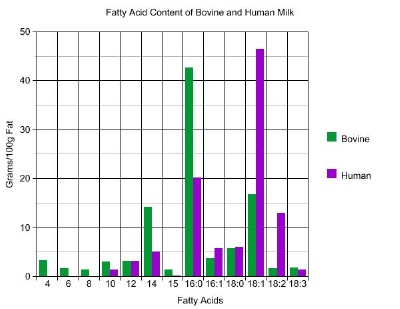Baby Formula

Without getting into the political controversy that continues to swirl around infant formula today, it's enough to say that there really is no perfect
substitute for mother's milk in your baby's first year of life.
Countless studies have shown that babies fed with mother's milk, instead of formulas, fare better in just about every way, from resistance to childhood ailments like ear infections and allergies, to having better skeletal structure and higher IQ's.
Commercial formulas got their start in 1867, when Henri Nestle (1814-1890, below, right) created one from cow's milk, wheat flour and sugar. Since then, literally hundreds, if not thousands of different blends were brewed up as replacements for mother's milk, the great majority of them falling far short of the mark.
Over the past century, mothers in western societies have sadly trended away from nursing in favor of bottle feeding, probably due to a mixture of societal changes, ignorance, indifference and unwillingness to deal with the inconvenience. Every effort should be made to breast-feed newborns. Only when that proves impossible should a formula be considered.

Luckily, food science, and painful lessons learned over decades of experimentation, have given us a pretty good idea of how to make substitutes for human milk. Consider that a baby's brain increases in weight from 350g (about 12 oz.) to about 800g (just over 28 oz.) during the first year of life. By age two, it's added another 400g.
That's almost two pounds of brain in as many years! It's safe to say that what you feed your child during this time of explosive cranial growth is probably some of the most important food it'll ever eat.
Whole, raw, grass-fed cow's milk, with some important additions, can augment, or, if necessary, replace mother's milk and ensure that all the right building blocks are being provided for optimum health and growth. The kind folks at the Weston A. Price Foundation have given me permission to include their recipe for baby formula that beats store-bought any day. Before we get to it, I'll add a little background on infant nutrition.
Human milk differs from bovine in a number of ways. Lactose (milk sugar) content for one. It has about 50% more than cow's milk, which comes in handy with all that nervous system construction going on. Why? Well, when lactose is digested, it breaks into one molecule each of glucose and galactose. So far, so good.
Now, galactose, it turns out, is a key component in myelin, an insulating material that wraps around the axons of many neurons (brain cells). Nerve impulses travel more quickly through axons with a proper coating of myelin. My guess is that intelligence is pretty closely linked with neuron firing speed, so adding extra lactose to cow's milk destined for growing human brains seems like a good idea.
Mother's milk is also higher in whey proteins, some of which make casein, the other milk protein, easier to digest. Adding extra whey and some powdered gelatin (not Jello!) can help make the casein in cow's milk more digestible for babies as well.
To make whey (hey!) just fill a clean quart mason jar with raw milk and set it on the counter at room temperature. Be sure to drape a clean cloth or paper towel over the opening to keep out airborne dust and microbes.
The thin, yellowish liquid that separates out after 3-4 days is the whey. It'll keep, covered in the fridge, for up to six months. Save the white stuff, too! Drain it for a day or so in cloth mesh and you'll have tasty cream cheese.
The fat profile of human milk differs appreciably from cow's milk as well, as you can see from the chart below. Notice that cow's milk is higher in the short and medium chain fatty acids than mother's milk. Human milk, on the other hand, is richer in the longer chain unsaturated and polyunsaturated fatty acids (PUFAs).

By adding cod liver, coconut, olive and sunflower oils to the formula, the fat profile, including long chain PUFAs like arachidonic (AA) and docosahexaenoic acid (DHA) is brought closer in line to that of breast milk, along with adding additional fat-soluble vitamins.
And speaking of vitamins, a small quantity of acerola powder (for vitamin C), and nutritional yeast (for folic acid, B vitamins and minerals) both bolster the nutrient profile even further.
Finally, the addition of Bifidobacterium infantis, a probiotic strain of bacteria found in the intestines of breast-fed infants, is thought to be useful in warding off infantile diarrhea by suppressing the growth of harmful bacteria in the large intestine.
Sally Fallon's excellent cookbook, Nourishing Traditions, has a terrific section on feeding babies that's a must read for all parents to be. You can find it on the Selected Books page. I highly recommend it!
RAW MILK-BASED BABY FORMULA From Weston A. Price Foundation
2 cups whole, raw milk from pasture-fed cows
1/4 cup homemade liquid whey
4 tablespoons lactose
1/4 teaspoon bifidobacterium infantis powder
2 or more tablespoons good quality raw cream, more if you are using milk from Holstein cows
1 teaspoon cod liver oil
1 teaspoon expeller-expressed sunflower oil
1 teaspoon extra virgin olive oil
2 teaspoons coconut oil (heat to 76° to liquify)
2 teaspoons nutritional yeast flakes
2 teaspoons gelatin
1 7/8 cups filtered water
1/4 teaspoon acerola powder
Add gelatin to water and warm until granules dissolve. Put this and all the other ingredients into a blender and mix well. Transfer to a clean glass or stainless steel container for storage.
To Serve:
Pour 6-8 ounces into a clean glass bottle, attach nipple and heat gently in a pan of simmering water. Don't over do it, just enough so it's warm to the touch, then shake well and feed.
WARNING! DO NOT USE FLUORIDATED WATER IN ANY BABY FORMULA! YOU WILL DAMAGE YOUR CHILD'S BRAIN!